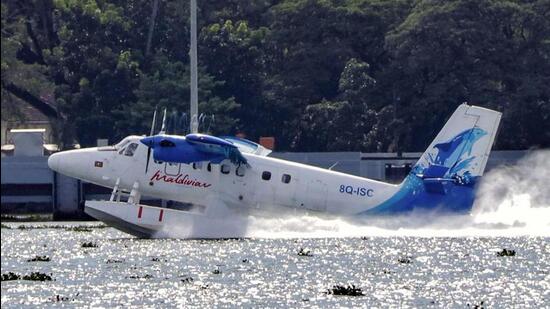Gujarat’s seaplane project may get relaunched before assembly polls: Official
The services were halted in April 2021 after SpiceJet’s subsidiary SpiceShuttle pulled out due to some operational difficulties amid the Covid-19 pandemic
The seaplane project envisioned by Prime Minister Narendra Modi ahead of the 2017 Gujarat elections is set to get a new lease of life in a couple of months, more than a year after being suspended.

The development comes just in time for the state assembly polls, scheduled to be held around the end of this year.
“There is no deadline pressure. We want to ensure that everything is in place before the services resume. If all goes as per plan, we aim to resume the seaplane services in the next one or two months,” said Captain Ajay Chauhan, director of civil aviation, Gujarat.
The services were halted in April 2021 after SpiceJet’s subsidiary SpiceShuttle pulled out due to some operational difficulties amid the Covid-19 pandemic. During its run, 276 seaplanes operated to ferry 2,192 passengers, including boarding 1,217 from Ahmedabad and 975 from Kevadiya. The ticket prices were capped at ₹5,000 for one-way travel.
“There have been challenges and there have been some very deep learnings. Apart from issues such as maintenance and operations, there were also security aspects that were to be looked into. We have made very good progress and overcome the challenges,” Chauhan said.
The Gujarat State Aviation Infrastructure Company Limited (GUJSAIL), a public sector undertaking, has now awarded the tender to Mumbai-based Maritime Energy Heli Air Services Pvt Ltd to relaunch the services. The company is in the final stages of importing a pre-owned Cessna Grand Caravan 208 amphibian from the United States.
GUJSAIL invited the tender under the state viability gap funding (VGF) scheme. The service will be operated six days a week, with the VGF for a maximum of 100 hours per month.
Also Read:After suspension of flights last year, Seaplane service to restart as bids open
The Gujarat government has made a budgetary provision of ₹65 crore for the year 2022-23 for the resumption of services, which includes infrastructure cost to build two sea aerodromes ( ₹7 crore) and developing sea plan services under Varuna Vayu Seva, according to a Gujarat government official.
The official added that the state government is yet to give its nod to a proposal from GUJSAIL to buy the aircraft, in the absence of which it will have to be leased.
Listing out some of the issues and the remedies taken, Chauhan said the earlier 19-seater aircraft was registered in the US. It required a foreign crew, which increased expenses and there also were issues related to travel restrictions as it needed daily clearances from the Directorate General of Civil Aviation (DGCA).
“The aircraft used for relaunch will be Indian registered, so there is no need of daily clearances from the DGCA. Also, the new plane has a carrying capacity of nine people and is amphibious unlike the earlier one. Earlier, the operator had to go to Maldives for maintenance or repair purposes, but now it can be done at GUJSAIL’s MRO facility in Ahmedabad,” Chauhan said.
GUJSAIL has come up with an Indian model of water-aerodrome at Sabarmati Riverfront and another at Kevadia after studying water-aerodrome (terminal) infrastructure in countries such as the US, Canada, the Maldives and Australia.
The seaplane services were the first of its kind introduced in the country and GUJSAIL has prepared a two-pronged approach to make operations a success this time.
“They include forming a dedicated special purpose vehicle (SPV) to operate sea plane services with Sagarmala project. This SPV, likely to be called ‘Varuna Vayu Sewa’, will provide sustainable seaplane services and consultancy for development of water aerodromes,” Chauhan added.
Sixteen water aerodromes have been proposed in India as part of the Sagarmala project, under the Union port and shipping ministry, and GUJSAIL aims to develop seaplane services with 19-seater amphibious sea planes in all these places.
“One of the advantages we have is that there are lot of waterbodies and dams for seaplanes to land. They can cater to a lot of tourist traffic like the Statue of Unity. From a regulatory viewpoint, we need to make them more functional for smaller aircraft. We can look at countries like Nepal that rely on smaller aircraft to bring this kind of regulation. Seaplane services have great potential for link-ups, for example, the Sabarmati riverfront is closer to Ahmedabad airport. Seaplanes are a success in countries such as Canada,” said professor Sebastian Morris, who teaches economics, public policy and governance at the Goa Institute of Management.
The Congress’ social media campaign during the 2017 state elections – ‘Vikaas Gaando Thayo Chhe’ (development has gone berserk) – gave the party a big fillip in setting an anti-Bharatiya Janata Party (BJP) narrative.
The BJP’s counter ‘Hun Chhu Vikas, Hun Chhu Gujarat’ (I am Gujarat, I am development) failed to make a mark amid Congress leader Rahul Gandhi’s efforts to puncture the ruling party’s claims of development projects in Gujarat.
But, on the last day of the campaign, PM Modi took to the skies in a seaplane from Ahmedabad’s Sabarmati riverfront to Dharoi dam in Mehsana, giving a befitting reply to Gandhi.
Though the Congress put up its best performance in two decades, it was not enough to stop BJP from winning in 2017 for the sixth consecutive time.
The seaplane project in Gujarat, which got stuck for a while due to commercial feasibility and the coronavirus pandemic, aims to create a second level of air connectivity for passengers in India.
PM Modi inaugurated the services by travelling from Kevadia, where the Statue of Unity is located, to Sabarmati Riverfront in Ahmedabad on October 31, 2020.





